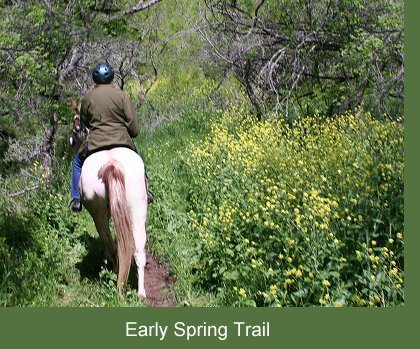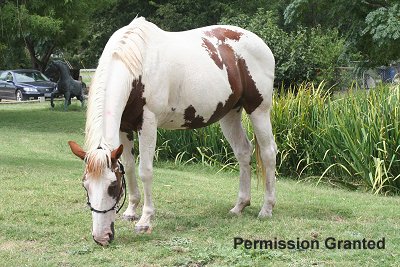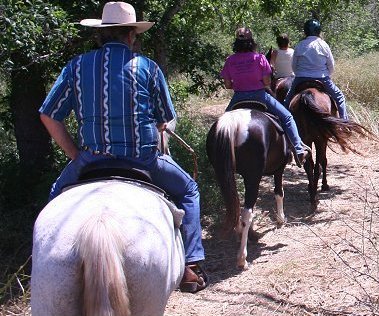 It can be highly irritating to be taking a long, slow, beautiful trail ride and have your horse continually diving to the ground for a morsel of grass or grabbing tall grasses from the side of the trail. It jars you every time, and can whip the reins right out of your gentle, relaxed hands. My reins are tied in such a way that they lie relaxed behind the saddle horn and it pinches my little finger between the reins and the horn if my mare dives unexpectedly. The whole tenor of the ride can change.
It can be highly irritating to be taking a long, slow, beautiful trail ride and have your horse continually diving to the ground for a morsel of grass or grabbing tall grasses from the side of the trail. It jars you every time, and can whip the reins right out of your gentle, relaxed hands. My reins are tied in such a way that they lie relaxed behind the saddle horn and it pinches my little finger between the reins and the horn if my mare dives unexpectedly. The whole tenor of the ride can change.
The problem can be solved, but it starts BEFORE the trail ride.
Your horse should know that work time is work time and eating time is eating time.
Horses who stop to graze just whenever they desire may be highlighting their position in the “herd” over you. Remember that pasture etiquette prescribes that the dominant horse controls the feeding – the resources, the space and the time. By wresting control of eating from you, you have lost a step on the rung of respect.
It is very easy to get in the habit of going to the pasture, haltering and bringing him in for tacking but letting him stop on the way to grab a mouthful – especially if he is in a fairly bare paddock and will be led across lush grass turnout spaces. You are enjoying his company. You are feeling benevolent and permissive. You see no harm on this relaxed day in his eating a little on the way.
Or perhaps you stop to talk to someone, and you “don’t mind” if he eats a little while you chat.
BUT eating while haltered in your presence is actually the first stage of misbehaving on the trail.
He must NEVER be allowed to graze in your presence without express permission. If he tries, (using a rope halter that has some bite) snap his head up quickly and continue your walk or work as if nothing happened. Most horses will learn from this uncomfortable reprimand and stop thinking about it (unless you are wishy-washy and inconsistent – sometimes allowing it and sometimes not. How badly do you want to extinguish the nibbling behavior?)
If you horse is particularly stubborn:
I have a quick way of dealing with the determined stop-and-munch behavior on the ground. You are probably wearing boots. When my horse dives down, I use the side of my boot to smartly bump his nose/lips and then walk on. I don’t mean violently “kick” and bruise – no toe here. It should not be physically damaging but it SHOULD be irritating and mildly uncomfortable. The “bump” must be smart enough that he throws his head up in startle, and he wonders what got into you. I pretend that nothing happened. He usually immediately tries it again, with the same result. “What has gotten into you? Are you crazy?” I just let it soak in that I have developed an uncontrollable foot that jumps out if he puts his muzzle into the grass. I am “challenged” in the sense that my boot just can’t be controlled in that situation.
Start with the mildest bump that will bring his head up. If he is very persistent, raise the ante to a quicker, harder bump. Escalate this until it is uncomfortable enough for him to think twice. Use as little force as possible but as much as is needed to stop the eating and pay attention to you.
 Be consistent. He must NEVER eat while wearing his halter and lead unless you physically lower his head down (and maybe step away from him) to give your permission. To mis-quote Ralph Waldo Emerson, “Inconsistency is the hobgoblin of good training”.
Be consistent. He must NEVER eat while wearing his halter and lead unless you physically lower his head down (and maybe step away from him) to give your permission. To mis-quote Ralph Waldo Emerson, “Inconsistency is the hobgoblin of good training”.
After two or three bumps, as you walk on, you will probably see your horse start to lower his head (as was the old habit), think about it, and continue on without the bite. It’s kind of fun to see the thought run through his mind and see him make the right decision. Give him a gentle rub on the neck and tell him he is good as you walk forward.
On the trail: When you have accomplished consistent compliance on the ground
 Be considerate. A little grazing or breakfast is necessary for a good start to the ride.
Be considerate. A little grazing or breakfast is necessary for a good start to the ride.
Taking your horse out without his breakfast or snack is like taking you to the donut shop while someone enjoys a nice cup of coffee and you must stand quietly through the doughnuts. Be sure he has had his hay and/or grain before you start his work day.
Common sense will tell you that he will be less tempted if his belly is always full and his need to forage is reduced. However, even a full, satisfied horse may be tempted by lush, “foreign” grass along the way. My favorite old mare is about as fat as she can be, and grass on the trail is her favorite part of the trip.
A horse who is continually waiting for the right time to make the dive is not paying attention to you. While it is nice to relax, during the time you are breaking this behavior you should also be paying attention to your surroundings. If you see a particularly lush area of the trail coming up, hasten your pace to get through it without incident. Notice tall grassy areas too, and speed up there as well. My horse is driven crazy by Johnson grass as tall as her head. We move through those areas at a faster speed, and she can STILL manage a mouthful unexpectedly.
At any rate, if your horse’s head dives down you will be at a standstill. Start tap, tap, tapping on his neck with your reins or a crop if you have one. If his head comes up, rub and rest. If it goes down again, tap again. This is a slow process of irritating him every time he puts his head down. It takes much of the pleasure out of his oral compulsion, but this takes patience on your part.
Alternative method 1 – depending on the terrain and whether you have trail buddies with you:
When his head goes down, snap it back up with a sharp jerk on one rein (better than two reins) and then make him trot for a good distance. If eating always means more work, eating will be seen as undesirable.
Alternative method 2 Make an anti-grazing helper. Tie a cord from the horn of the saddle down through the top of his bridle to one side of the bit. make it loose enough that he has control of his head in a nice natural position at all gaits, but short enough that if he puts his head below the level, it snaps the cord and brings his head back up sharply. This is absolutely consistent, the timing is perfect, and it is highly irritating to the horse. (Don’t just loop another rein around the saddle horn. That can become highly irritating to you as well because it snaps both sides of the bit and gives him more leverage to jerk his head down, jerking the whole saddle with it).
Unfinished, More Coming Soon
Horse training and equestrian activities in general can be dangerous. While we try to present relevant and valuable content, under no circumstances does horse-pros.com or its members or contributors take any responsibility for the well-being of any horse or person using a method outlined here.
Please note that this advice is neither veterinary nor prescriptive in nature but offered only as an introduction to this topic.
We need your help. We certainly don’t know everything. Please share your expertise and experiences. Comment on what is already written or Suggest a Category and Educate us about it. Grow Horse-Pros.com©
